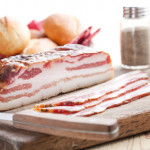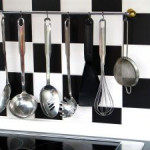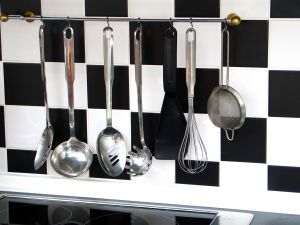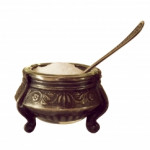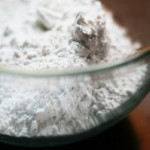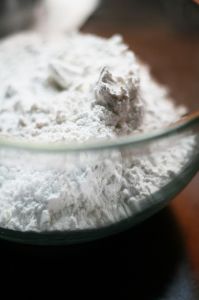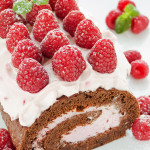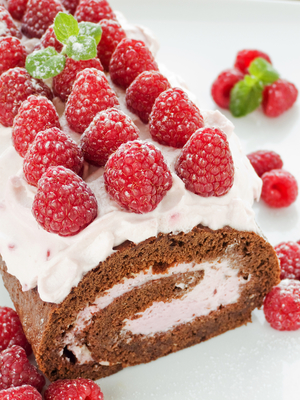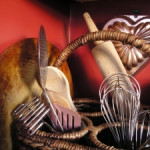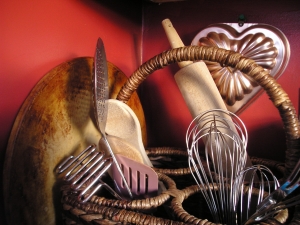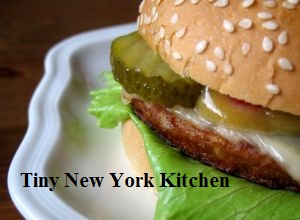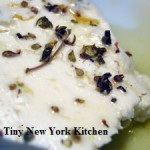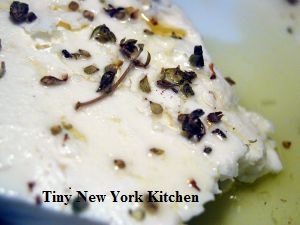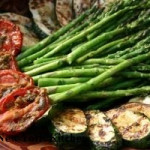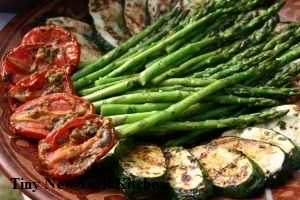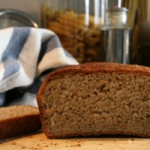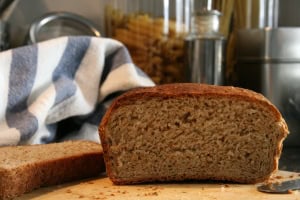Bacon is prepared from several different cuts of meat. It is usually made from side and back cuts of pork, except in the United Sates, where it is almost always prepared from pork belly. The side cut has more meat and less fat than the belly. Bacon may be prepared from either of two distinct back cuts: fatback, which is almost pure fat, or pork loin, which is very lean. Bacon cured pork loin is known as back bacon.
I like bacon that is thick and crispy, not thin and limp. I favor a 1/8-inch sliced bacon that is apple wood smoked for a full, sweet flavor that seems to complement, not overpower, other foods. You can buy this at a butcher’s shop where they will slice it for you from the slab. Many supermarkets now carry thick-sliced bacon.
A Few Words About Flour
Playing with different flours in your favorite recipes can create new flavors, aromas and textures. Try using a little of another kind of flour in recipes that call for refined white flours; aside from having less flavor, white flour has been stripped of most of its fiber, minerals and vitamins. For people with wheat sensitivities, there are quite a few non-wheat flours.
Substituting For Wheat
While all grains can be ground to make flour, they are not all interchangeable with wheat. Each grain has its own personality, and flours have textures that range from silky to grainy. When experimenting with substituting them for white flour, do so a little at a time. For instance, if a recipe calls for 1 cup of wheat flour, substitute 1/4 cup of another variety. See how that works, and then add more or less alternative flour depending on the success of your results.
Storing Flour
Make sure to store flours in a cool, dark place, preferably the refrigerator or even the freezer. Allow flour to come to room temperature for accurate measuring.
Gluten Levels And Why They Matter
It is important to keep in mind that all wheat flour contains a high amount of a protein known as gluten. Gluten is responsible for the stretchiness of dough, which allows it to hold air bubbles during rising, producing light and shapely baked goods. If using a large amount of non-wheat flour for baking, you may need to add wheat gluten (basically wheat flour without the starch) in order to produce uniform, well-risen baked goods. In recipes where rising is less of an issue (for coatings or pancakes, for example), there is no need to add gluten.
Flour Varieties
Let’s go over the varieties flour varieties available.
Amaranth: A strong, spicy, nutty-flavored flour. Best used as an accent flour in waffles, pancakes, cookies or muffins. No Gluten.
Bran (Unprocessed): The outer layer of the wheat berry. Add small amounts to cereals and baked goods to increase fiber. Keep refrigerated. High Gluten.
Buckwheat: The edible fruit seed of a plant related to rhubarb. It is not related to wheat or other grains. High proportion of essential amino acids; close to being a complete protein. Commonly combined with wheat flour in pancakes, waffles, blintzes and pasta. Low Gluten.
Cornmeal (Blue): Higher in protein than yellow cornmeal. Turns lavender in color when cooked. Use in muffins and corn tortillas. Kids love purple pancakes! No Gluten.
Cornmeal (Yellow): Rich and buttery in flavor. Use for polenta, cornbread and muffins. No Gluten.
Gluten: Gluten flour is white flour mixed with concentrated wheat protein. Add to bread dough to increase rise: 2 tablespoons per cup of flour in whole grain bread: 1 tablespoon plus 1 teaspoon per cup of flour in white breads. Also add to breads with extra bran, raisins or nuts. Increase kneading time to activate extra gluten. High Gluten.
Graham: Hard whole wheat flour with a course and flaky outer bran layer, and finely ground germ. Most famously used in crackers, but adds texture and nutty flavor to all baked goods. Low Gluten.
Oat Bran: Contains soluble fiber, which can help lower blood cholesterol levels when eaten as part of a low cholesterol diet. Add oat bran to muffins or breads. Use as a coating for chicken and seafood. Low Gluten
Rye Flour: Yields baked goods that are moist and dense. Combine with caraway seeds in crackers and breads. Due to its low-gluten content, it is often mixed with whole wheat flour to increase its rising ability. Low Gluten
Semolina: Durum flour with the bran and germ removed. Never bleached. Used to make high-quality “white” pasta. Adds extra flavor and texture in some bread recipes. High Gluten
Soy: High in protein, it is often used as a protein booster. Usually combined with whole wheat flour to increase its rising ability. No Gluten.
Spelt: An ancient grain gaining popularity today as a wheat substitute. Similar to high protein wheat. If substituting for wheat in a recipe, reduce the liquid by 25%. Low Gluten
Teff: Rich in calcium, protein and iron; sweet malty flavor. Use in quick breads, pancakes and waffles. Use to thicken stews, soups and sauces. Teff is a major crop in Ethiopia, where the flour is used to make the typical spongy flatbread infera. No Gluten
Wheat Germ: Vitamin and mineral-rich layer of the wheat berry. Excellent source of vitamin E. Available toasted and untoasted. Add to cereals, pancakes and baked goods, as well as meat or vegetable loaves. Refrigerate to prevent rancidity. High Gluten.
Whole Durum Wheat: From very high protein wheat with less starch than other wheat flours. Makes a tough dough that can stretch and expand – perfect for whole grain pasta. Nutritional profile similar to whole wheat. High Gluten.
Whole Wheat: Ground from entire wheat berry. Full-bodied flavor and course texture. Generally produces baked goods that are denser, with less rise than those made with white flour. Adds rustic, hearty qualities to baked goods. High Gluten.
Whole Wheat Pastry Flour: Ground from soft wheat berries. Higher in starch and lower in gluten than regular wheat flour. Use in non-yeast baked goods such as cookies, pancakes, muffins, quick breads and cakes. Medium Gluten.
Whipped Cream
I can’t stand that whipped topping stuff you find in the freezer section of the grocery store or that stuff that comes from a spray can. It’s so much better to make the real thing to top your awesome holiday desserts. Here is a super easy Whipped Cream recipe along with some helpful tips.
Whipped Cream Recipe
INGREDIENTS
1 Pint Organic Whipping Cream
1 Teaspoon Vanilla Extract
2 Tablespoons Sugar
For Spiced Whipped Cream add 3/4 teaspoon cinnamon.
For Maple Whipped Cream substitute 3 tablespoons maple syrup for sugar.
Chill all of the ingredients. Beat cream, slowly at first, until consistency is thick, oft and fluffy, or until soft peaks begin to form. Gradually blend in sugar, any spices, and vanilla, and beat until stiff peaks form. Do NOT over-whip.
Important Basics
*Use a deep/tall bowl, 2-quart or larger bowl. Cream doubles in volume when whipped, and a tall bowl reduces splatter.
*Use a whisk, handheld mixer, or standing mixer.
*Adding sweetener and spices is optional.
*Adding a small pinch of salt added to the cream at the beginning helps the whipping process but is optional.
*Cream whips best when it is cold. Keep your cream as cold as possible.
*Use a chilled bowl. Refrigerate for at least 15 minutes. Metal bowls get colder than glass bowls.
*Chill your whisk or beaters as well. Warm metal will transfer its heat to the cream.
*If your kitchen is warm, you may want to keep the bowl in a larger bowl of ice water during and after the whipping process. If winter you may want to work in front of an open window.
*Whipping cream can be quite messy as cream splatters, especially when using an electric mixer. To reduce splatter, start out slow, and gradually increase speed. As cream thickens, its tendency to splatter is reduced.
*Some chefs prefer to use powdered sugar, because the finer texture dissolves in the cream more readily than granulated sugar. Either granulated or powdered sugar will work, as will other sweeteners. Think maple syrup!
*Adding sugar too early in the whipping process will reduce the volume of whopped cream. For maximum whip, wait to add your sweetener, vanilla, and any spices until after the texture starts to thicken and soft peaks form. Add them slowly, from the side of the bowl.
*Whipped cream is ready when the cream forms stiff peaks. The process takes several minutes working with a whisk (depending on cream temperature and your technique), but be careful if using and electric mixer because it works quickly.
*Over-whipped cream will separate and turn to butter, which is delicious on toast, but not a topping for your desserts. If you catch the cream when it’s just starting to curdle, you may be able to salvage it by adding more cream and whisking by hand.
*If possible, whip the cream immediately before using. If not, or if you have leftovers, you can cover and refrigerate whipped cream for up to 24 hours. If the cream separates during storage, simply beat or whisk until cream has incorporated again. You can also revive tired whipped cream that has been sitting out by putting it in the freezer for 1/2 half hour or so, or twice as long in the fridge. Remove and rewhip.
Choose the right Feta for your dish!
Goat’s Milk Feta: Goes with pita bread, olives, grapes, cherry tomatoes & pasta
Sheep’s Milk Feta: Goes with watermelon and red onion salad, pizza, lamb & anchovies
Cow’s Milk Feta: Goes with Greek salad, olive oil, rosemary and thyme, black beans, soup or casseroles.
Did you know that Traditional Greek Feta is made with a combination of sheep and goat milk?
Feta is a white, semi-firm, crumbly, salty cheese made from sheep’s or goat’s milk (sometimes cow’s milk) and cured in brine. Originally from Greece, feta translates to “slice,” for one of the stages in its making. The word came into English around 1956. Feta is one of the world’s oldest cheeses. It has been made in Greece and other Balkan countries for centuries. Homer wrote about it, describing how the gods made the cheese.
The finest feta cheese should be purchased direct from its brine bath. If it is prepackaged, it should have some of the brine in the packaging to keep it moist. Feta cheese is best when eaten fresh, so always check the date. If you will not be consuming it immediately, store the feta in a brine or milk bath in the refrigerator. The milk bath will reduce the saltiness and help keep the cheese moist and last for up to 3 months. Freezing is not good for feta cheese. Feta that has been aged in barrels and sold straight from the barrel may be wrapped in a lightweight paper. You may want to wrap your feta in a plastic bag or plastic wrap and store in the fridge however there is some controversy about storing cheese in plastic. You may want to keep the feta in the paper, even when the paper gets soggy from the cheese moisture. Allow at least 30 minutes for feta to come to room temperature, to fully enjoy its rich, tangy flavor and creamy texture.
If you are one who doesn’t like feta’s salty taste then you may want to soak the cheese in fresh water to leach out some of the salt or tone down the salt in dishes that feta is used in. This allows the cheese to supply the salt.
Feta Vinaigrette
The slight sharpness of the feta combined with fresh green herbs makes a versatile vinaigrette dressing that goes beautifully with lightly steamed asparagus or sliced tomatoes as well as artichokes. It is a lovely dressing on potatoes, pasta or shrimp salad as well.
INGREDIENTS
1/4 Cup White Wine Vinegar
1 Teaspoon Minced Fresh Basil
1 Teaspoon Minced Fresh Dill
1 Teaspoon Minced Fresh Mint
1/2 Cup Finely Crumbled Feta Cheese
1/2 Cup Olive Oil
1/4 Cup Safflower Oil
1/4 Teaspoon Kosher Salt
1/4 Teaspoon Freshly Ground Pepper
In a small size bowl, whisk together the vinegar, herbs and cheese. Add the olive oil and safflower oil in a slow thin stream. Whisk constantly until combined and emulsified. Add the kosher salt and pepper. Set aside until you are ready to use. Cover and refrigerate. It will keep for up to 1 week. Stir or shake well before using. Makes 1 cup.
Spring is here and asparagus is in-season. Here are some ways to enjoy such a wonderful seasonal vegetable.
Quick Pickle: Combine vinegar, cumin, coriander, garlic and chile flakes and pour into a jar. Add the asparagus spears and place in the fridge for a few days. They should be nice and pickled. Eat them for a spicy snack or toss them into a salad.
Side Dish: Toss boiled slices of asparagus, leeks with mint and melted butter for a savory side dish.
Shave Raw: Shave raw asparagus spears and Parmigiano Reggiano, and then toss with tender asparagus tips, olive oil and lemon juice for a vibrant salad.
Grilled: Marinate the asparagus in olive oil and garlic for two hours before grilling. Grill alone or with other vegetables.
Roasted: Roast in the oven at 400º F drizzled with olive oil.
To Prepare For Cooking: Start at the base of each asparagus spear and work toward the tip. Bend the spear a few times until you find a place where it breaks easily. Snap off the woody base at that point. If you would like a clean, smooth look then use a vegetable peeler to scrape off the scales on the spears.
Standard Preparation: For 1 pound of asparagus (15 to 24 spears) Wash and snap off the woody bases where the spears break easily. If you like scrape off the scales. Leave the spears whole or cut into 1 inch pieces. You should get about 2 cups of asparagus pieces. Cook, covered, in a small amount of boiling salted water for 3 to 5 minutes or until crisp-tender. Or you can steam them for 3 to 5 minutes in a steamer insert. To microwave place in a baking dish or casserole dish with 2 tablespoons of water. Cover and microwave on high for 2 to 4 minutes or until crisp-tender.
Roasted Asparagus
INGREDIENTS
2 Pounds Asparagus
2 Tablespoons Olive Oil
1/4 Teaspoon Kosher Salt
1/4 Teaspoon Freshly Ground Pepper
1/4 Cup Shredded Parmesan or Asiago Cheese
Preheat your oven to 400º F. Snap off and throw away the woody bases from the asparagus. I you like, scrape off the scales. Please the asparagus in a medium size baking dish. Drizzle with olive oil and toss to coat. Spread the asparagus in a single layer. Sprinkle with the kosher salt and pepper. Place in the oven and roast, uncovered, for 15 to 20 minutes or until the asparagus are crisp-tender. Turn once halfway through the cooking process. Remove from the oven and transfer to a serving platter. Sprinkle with the shredded cheese. Serves 4

